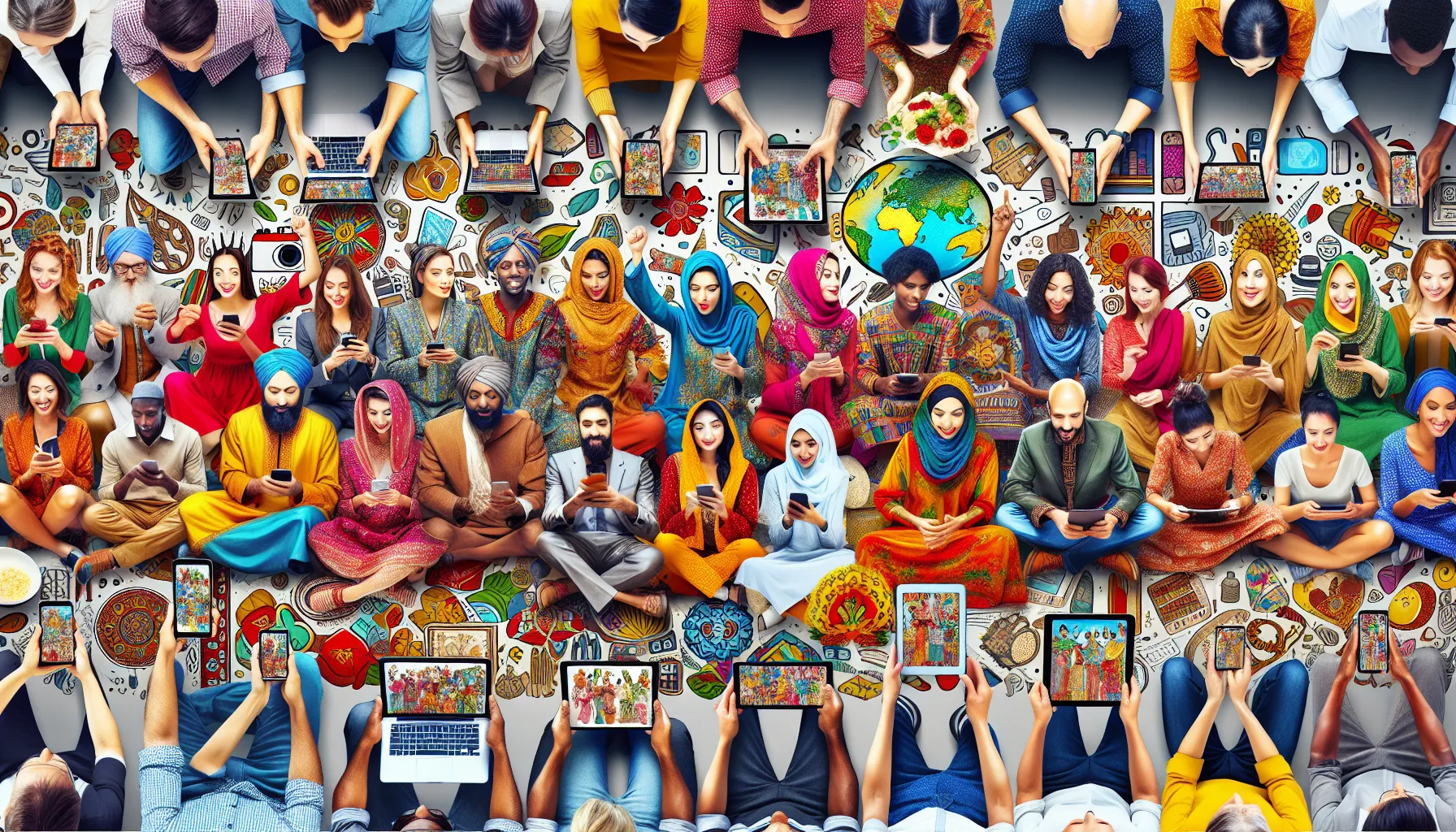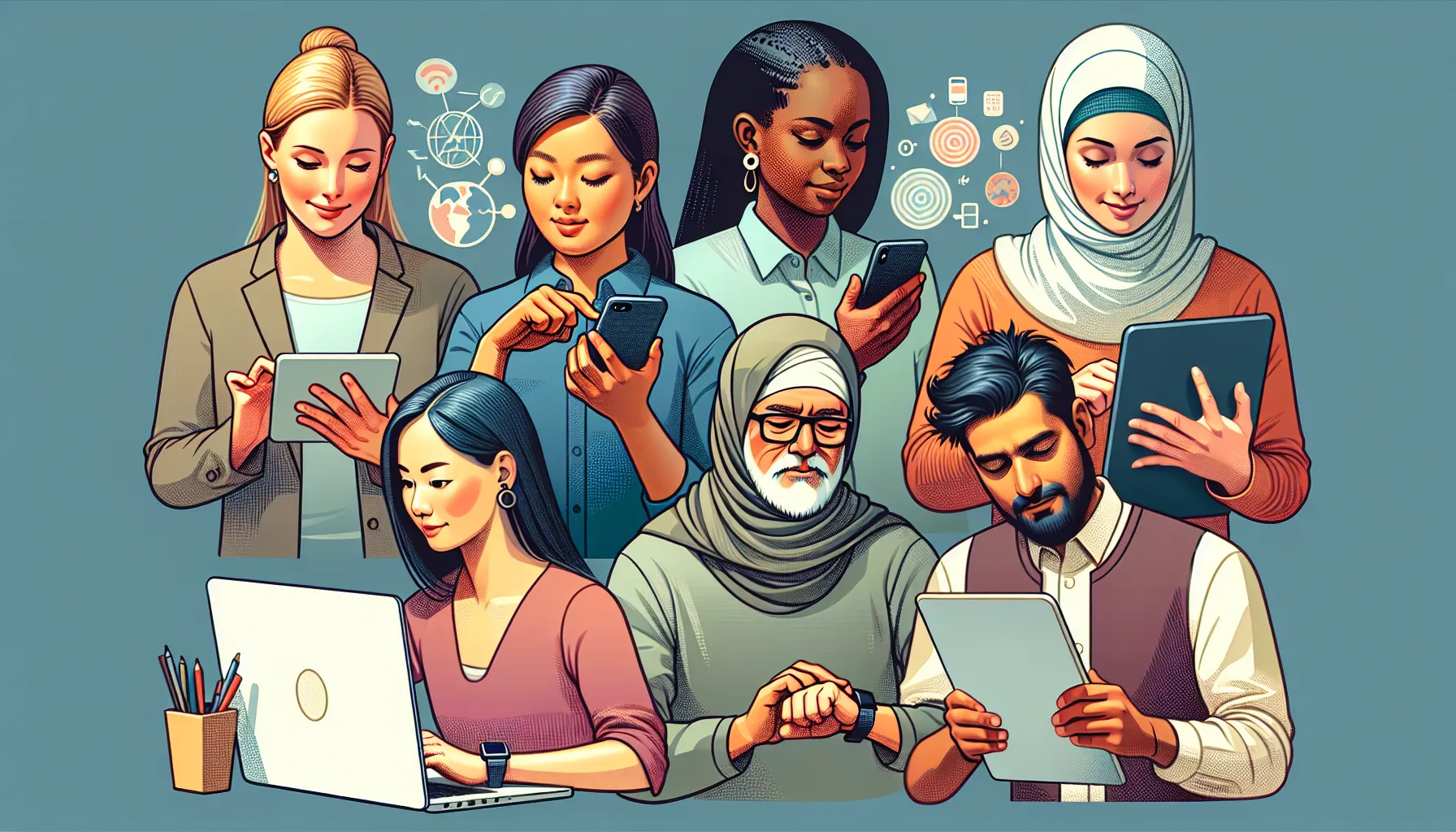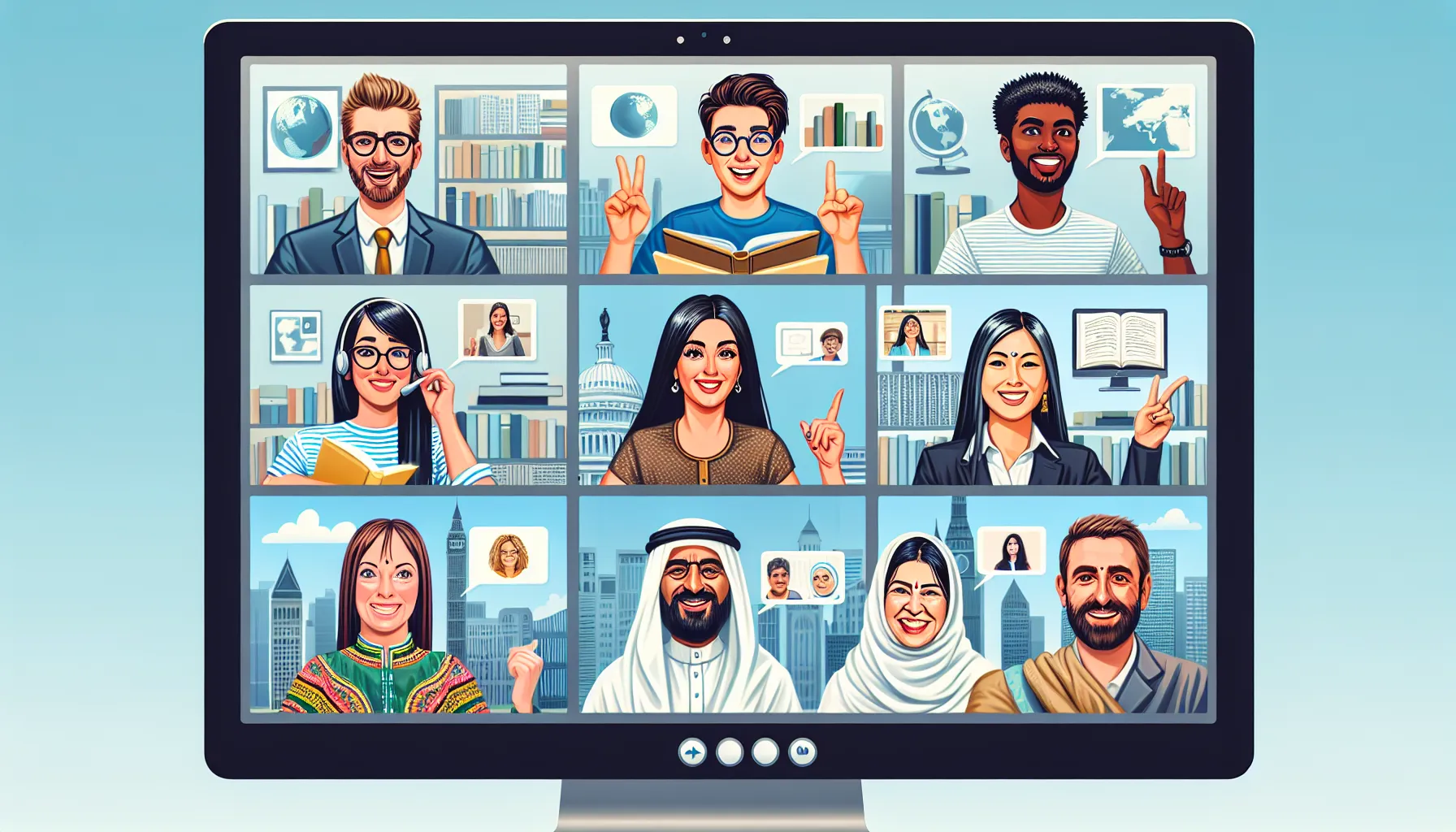In today’s digital age, online platforms have become powerful tools for cultural self-expression. This IELTS Reading practice test focuses on this fascinating topic, exploring how various digital platforms enable individuals and communities to share their cultural identities, traditions, and artistic expressions with a global audience. Let’s dive into the passages and questions to enhance your reading skills while learning about this important aspect of our interconnected world.
Nội dung bài viết
- Passage 1 (Easy Text)
- The Rise of Digital Cultural Platforms
- Questions 1-5
- Questions 6-10
- Passage 2 (Medium Text)
- Digital Preservation of Indigenous Knowledge
- Questions 11-15
- Questions 16-20
- Passage 3 (Hard Text)
- The Democratization of Cultural Narratives in the Digital Age
- Questions 21-26
- Questions 27-33
- Questions 34-40
- Answer Key
- Passage 1
- Passage 2
- Passage 3
 Cultural self-expression online
Cultural self-expression online
Passage 1 (Easy Text)
The Rise of Digital Cultural Platforms
In recent years, the internet has revolutionized the way we express and share our cultural identities. Social media platforms, blogs, and video-sharing websites have become virtual stages for individuals and communities to showcase their traditions, art, and customs to a global audience. These digital spaces offer unprecedented opportunities for cultural preservation and dissemination, allowing even the most niche cultural practices to find their audience.
One of the most significant advantages of online platforms is their accessibility. Unlike traditional media, which often requires substantial resources to reach a wide audience, digital platforms allow anyone with an internet connection to share their cultural experiences. This democratization of cultural expression has led to a vibrant tapestry of voices and perspectives that were previously underrepresented in mainstream media.
Moreover, these platforms facilitate cross-cultural dialogue and understanding. Users can easily explore and engage with cultures different from their own, fostering a sense of global community. This exposure to diverse cultural expressions can lead to increased empathy and appreciation for the rich variety of human experiences around the world.
However, the digital realm also presents challenges. The sheer volume of content can make it difficult for individual voices to be heard, and there are concerns about the authenticity of cultural representations online. Additionally, the digital divide means that not all communities have equal access to these platforms, potentially leading to the marginalization of certain cultural expressions.
Despite these challenges, the overall impact of online platforms on cultural self-expression has been overwhelmingly positive. They have created new opportunities for cultural preservation, education, and exchange, empowering individuals and communities to share their unique identities with the world.
Questions 1-5
Do the following statements agree with the information given in the reading passage?
Write:
TRUE if the statement agrees with the information
FALSE if the statement contradicts the information
NOT GIVEN if there is no information on this
- Online platforms have made it easier for people to share their cultural identities globally.
- Traditional media is more effective than digital platforms in reaching a wide audience.
- Digital platforms have led to increased cross-cultural understanding.
- All communities have equal access to online platforms for cultural expression.
- The impact of online platforms on cultural self-expression has been mostly negative.
Questions 6-10
Complete the sentences below.
Choose NO MORE THAN TWO WORDS from the passage for each answer.
- Digital platforms act as __ __ for showcasing cultural traditions and art.
- The __ of cultural expression on digital platforms has resulted in a diverse range of voices being heard.
- Exposure to different cultures online can increase __ and appreciation for global diversity.
- One challenge of online cultural expression is maintaining the __ of cultural representations.
- Despite challenges, online platforms have created new opportunities for cultural __ and education.
Passage 2 (Medium Text)
Digital Preservation of Indigenous Knowledge
The digital age has ushered in a new era for the preservation and revitalization of indigenous cultures. Online platforms have become invaluable tools for indigenous communities to document, share, and promote their traditional knowledge, languages, and cultural practices. This digital preservation effort is crucial in the face of globalization and the homogenization of cultures, which often threaten the survival of indigenous ways of life.
One of the most significant contributions of online platforms is in the area of language preservation. Many indigenous languages are at risk of extinction, with some having only a handful of fluent speakers left. Digital platforms provide a space for these languages to be recorded, taught, and used actively. Language learning apps, online dictionaries, and social media groups dedicated to indigenous languages have emerged, allowing speakers to connect across vast distances and share resources.
Moreover, digital storytelling has become a powerful medium for preserving oral traditions. Podcasts, YouTube channels, and interactive websites now host countless stories, myths, and legends that might otherwise be lost to time. These platforms not only preserve the content of these stories but also capture the nuances of oral storytelling traditions, including intonation, pacing, and performance styles.
The digitization of traditional art forms has also opened up new avenues for cultural expression and economic opportunities. Online marketplaces have enabled indigenous artisans to reach global audiences, selling their crafts and artwork directly to consumers worldwide. This has not only helped preserve traditional craftsmanship but has also provided a sustainable income source for many indigenous communities.
However, the use of digital platforms for cultural preservation is not without its challenges. Issues of intellectual property rights and cultural appropriation have become more pronounced in the digital sphere. There is a delicate balance between sharing cultural knowledge and protecting it from misuse or exploitation. Additionally, the digital divide remains a significant barrier for many indigenous communities, particularly those in remote areas with limited internet access.
Despite these challenges, the potential of online platforms to support indigenous cultural preservation is immense. They offer a dynamic and accessible way to keep traditions alive, engage younger generations, and foster cross-cultural understanding. As technology continues to evolve, it is likely that we will see even more innovative approaches to digital cultural preservation, ensuring that indigenous knowledge and practices remain vibrant and relevant in the modern world.
Questions 11-15
Choose the correct letter, A, B, C, or D.
-
According to the passage, online platforms are important for indigenous cultures because they:
A) Replace traditional cultural practices
B) Help preserve and promote traditional knowledge
C) Provide entertainment for indigenous communities
D) Increase tourism in indigenous areas -
The text suggests that digital platforms are particularly useful for:
A) Replacing indigenous languages with more common ones
B) Preserving endangered indigenous languages
C) Teaching only written forms of indigenous languages
D) Discouraging the use of indigenous languages -
Digital storytelling on online platforms:
A) Only preserves the content of stories
B) Is less effective than traditional oral storytelling
C) Captures both content and performance aspects of oral traditions
D) Is not popular among indigenous communities -
Online marketplaces for indigenous art:
A) Have no impact on traditional craftsmanship
B) Only benefit large corporations
C) Help preserve traditional crafts and provide income
D) Are not accessible to indigenous artisans -
The main challenge in using digital platforms for cultural preservation is:
A) Lack of interest from indigenous communities
B) The high cost of technology
C) Balancing sharing and protecting cultural knowledge
D) The inability to accurately represent indigenous cultures online
Questions 16-20
Complete the summary below.
Choose NO MORE THAN TWO WORDS from the passage for each answer.
Online platforms offer numerous benefits for indigenous cultural preservation. They are particularly useful for preserving endangered (16) __, with various digital tools available for learning and practicing these languages. Digital storytelling through platforms like podcasts and (17) __ helps preserve oral traditions. The digitization of traditional art has created new (18) __ opportunities for indigenous artisans. However, challenges exist, including issues related to (19) __ and cultural appropriation. Despite these challenges, online platforms have great (20) __ for supporting indigenous cultural preservation and fostering cross-cultural understanding.
Passage 3 (Hard Text)
The Democratization of Cultural Narratives in the Digital Age
The advent of digital platforms has precipitated a paradigm shift in the way cultural narratives are constructed, disseminated, and consumed. This technological revolution has democratized the process of cultural storytelling, enabling individuals and communities to bypass traditional gatekeepers and directly share their experiences, traditions, and perspectives with a global audience. The implications of this shift are profound, reshaping our understanding of cultural identity, authenticity, and representation in the 21st century.
One of the most salient features of this digital cultural renaissance is the decentralization of narrative authority. Historically, the power to shape cultural narratives was concentrated in the hands of a select few—academics, media conglomerates, and cultural institutions. The proliferation of social media platforms, blogs, and user-generated content sites has disrupted this monopoly, allowing for a more diverse and polyphonic representation of cultural experiences. This democratization has given rise to counter-narratives that challenge dominant cultural discourses and provide visibility to marginalized voices.
The participatory culture fostered by these platforms has also blurred the lines between creators and consumers of cultural content. The concept of prosumers—individuals who both produce and consume media—has become increasingly relevant in the digital cultural landscape. This shift has led to a more dynamic and interactive form of cultural exchange, where traditions are not merely preserved but actively reinterpreted and transformed through collaborative online engagement.
Moreover, the hyper-connectivity of the digital age has facilitated unprecedented levels of cultural hybridization. As cultural expressions from diverse corners of the globe intersect and interact in virtual spaces, new syncretic forms of cultural identity emerge. This process of cultural fusion challenges essentialist notions of cultural authenticity and highlights the fluid, adaptive nature of cultural identity in a globalized world.
However, the democratization of cultural narratives through digital platforms is not without its complexities and contradictions. The algorithmic curation of content on many platforms can create echo chambers that reinforce existing cultural biases rather than promoting genuine cross-cultural dialogue. Furthermore, the commercialization of personal data and cultural content raises ethical questions about the commodification of cultural identity in the digital realm.
The issue of digital colonialism also looms large in this context. While online platforms ostensibly offer equal opportunities for cultural expression, the underlying technological infrastructure and dominant platforms are largely controlled by a handful of Western corporations. This power imbalance raises concerns about the potential for cultural homogenization and the perpetuation of neo-colonial power structures in the digital sphere.
Despite these challenges, the potential of digital platforms to support and amplify diverse cultural voices remains significant. As we navigate the complexities of cultural expression in the digital age, it is crucial to develop critical digital literacy skills that enable users to engage thoughtfully with online cultural content. By fostering a more nuanced understanding of the opportunities and limitations of digital cultural expression, we can work towards a more equitable and pluralistic global cultural landscape.
Questions 21-26
Complete the summary below.
Choose NO MORE THAN TWO WORDS from the passage for each answer.
The rise of digital platforms has led to a (21) __ in how cultural narratives are created and shared. This has resulted in the (22) __ of narrative authority, allowing for more diverse cultural representations. The concept of (23) __, who both create and consume content, has become important in this new landscape. Digital platforms have also facilitated cultural (24) __, leading to new forms of cultural identity. However, challenges such as (25) __ and the risk of digital colonialism exist. To navigate these complexities, developing (26) __ skills is crucial for engaging with online cultural content.
Questions 27-33
Do the following statements agree with the claims of the writer in the reading passage?
Write:
YES if the statement agrees with the claims of the writer
NO if the statement contradicts the claims of the writer
NOT GIVEN if it is impossible to say what the writer thinks about this
- Digital platforms have completely eliminated the role of traditional cultural gatekeepers.
- The democratization of cultural narratives has led to more diverse representations of cultural experiences.
- Participatory culture on digital platforms has made cultural traditions static and unchanging.
- The hyper-connectivity of the digital age has resulted in increased cultural hybridization.
- Algorithmic curation of content always promotes genuine cross-cultural dialogue.
- The commercialization of cultural content on digital platforms raises ethical concerns.
- Western corporations’ control over major digital platforms has no impact on cultural expression online.
Questions 34-40
Complete the sentences below.
Choose NO MORE THAN THREE WORDS from the passage for each answer.
- The decentralization of narrative authority has allowed for the emergence of __ that challenge dominant cultural discourses.
- The concept of __ refers to individuals who both produce and consume media in the digital cultural landscape.
- The process of __ in virtual spaces challenges traditional notions of cultural authenticity.
- The __ of content on many digital platforms can reinforce existing cultural biases.
- The control of technological infrastructure by Western corporations raises concerns about __ in the digital sphere.
- To engage thoughtfully with online cultural content, it is important to develop __ skills.
- By understanding the opportunities and limitations of digital cultural expression, we can work towards a more __ global cultural landscape.
Answer Key
Passage 1
- TRUE
- FALSE
- TRUE
- FALSE
- FALSE
- virtual stages
- democratization
- empathy
- authenticity
- preservation
Passage 2
- B
- B
- C
- C
- C
- languages
- YouTube channels
- economic
- intellectual property rights
- potential
Passage 3
- paradigm shift
- decentralization
- prosumers
- hybridization
- algorithmic curation
- critical digital literacy
- NO
- YES
- NO
- YES
- NO
- YES
- NO
- counter-narratives
- prosumers
- cultural fusion
- algorithmic curation
- cultural homogenization
- critical digital literacy
- equitable and pluralistic
As we conclude this IELTS Reading practice test on how online platforms support cultural self-expression, it’s important to reflect on the profound impact digital technologies have on our cultural landscapes. These passages have highlighted the opportunities and challenges that come with digital cultural expression, from preserving indigenous languages to reshaping global narratives.
For IELTS test-takers, this topic demonstrates the complexity of issues you may encounter in the Reading section. It requires you to engage with academic concepts, understand nuanced arguments, and interpret information from various perspectives. Practice tests like this one are crucial for developing the critical reading skills necessary for success in the IELTS exam.
Remember, when approaching IELTS Reading passages:
- Skim the text first to get a general idea of the content.
- Pay attention to headings, subheadings, and topic sentences.
- Underline key terms and concepts as you read.
- Practice time management to ensure you can complete all questions within the allotted time.
By honing these skills and expanding your knowledge on contemporary topics like digital cultural expression, you’ll be well-prepared for the IELTS Reading test. Keep practicing, and don’t hesitate to explore related topics such as the cultural influence of social media and the impact of social media on personal identity to broaden your understanding of these interconnected themes.


